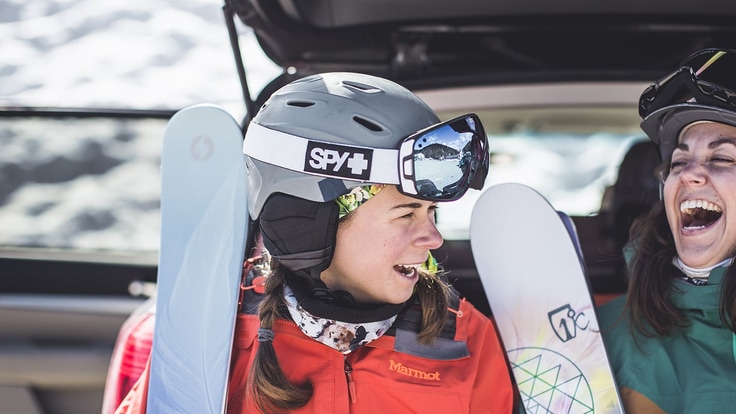You don't have to ski the trees or catch big air to appreciate a helmet. All skiers and riders can enjoy the benefits and warmth that a helmet provides.
All ski and snowboard helmets sold at REI Co-op meet the most common U.S.-based standard for snow helmet certification, known as ASTM F2040. Some also meet CE EN1077 standards, a European certification for alpine skiing and snowboarding helmets. (These certifications cover nonmotorized recreational snowsports). That said, when wearing your helmet, remember that they are valuable but not invincible, and any protection they may provide is limited.
Ski / Snowboard Helmet Components
Just like running shoes differ from hiking boots, snow helmets are different from bike or skateboard helmets. They have specific features such as ear coverage, moisture-wicking liners and temperature-sensitive materials.
Shell: The shell, or outer layer of the helmet, is a rigid surface (typically ABS high-impact plastic) that can help protect the head against sharp objects, knocks and abrasions. It also helps spread impact energy over a larger portion of the helmet during a fall.
Inner liner: This is typically made from EPS (expanded polystyrene) foam, the material that looks like Styrofoam®. It's designed to absorb impact. In a hard fall, the liner foam can get compressed, a condition that you may or may not be able to discern. A helmet should always be destroyed and replaced after a serious fall.
Ski / Snowboard Helmet Construction
In-mold helmets: These are made by attaching the shell and shock-absorbing foam in a single molding process. They are sleek and much lighter than injection-molded helmets.
Injection-molded helmets: These use an EPS foam bonded to a separate shell, usually made of high-impact ABS plastic. These helmets offer more durability against everyday knocks and falls compared to in-mold helmets.
Some helmets have detachable ear pads and liners for adjustable warmth.
Ski / Snowboard Helmet Sizing and Fit
If possible, try on helmets at your local REI store to find one that is most comfortable. It should fit comfortably and sit on your head correctly for best protection. (Tip: Bring your goggles with you to the store and try them on with the helmet.)
Measuring for your size: You can find your correct size by measuring your head or, if you're at your REI store, just by trying on sizes. If using a tape measure, position it just above the ears and about 1" above your eyebrows. Measure around the largest part of your head (keeping the tape level) to determine the circumference of your head. Look at the chart on the helmet packaging to find your best size.
Checking the fit: A good helmet should feel snug but not tight. If the helmet can rock back and forth, the fit is too loose. Shake your head from side-to-side. If the helmet shifts, try a smaller size, adjust the sizing mechanism or use thicker sizing pads. Push up the front and back edges. If they move, tighten the straps.
There should be no gap between the top of your goggles and the helmet. Make sure the helmet fits snugly to the top of the goggles, but not so low that it hinders vision or pushes down the goggles.
The helmet should be positioned low enough in the front to protect your forehead. It should sit level with its front edge no more than 1" above the eyebrows. Finally, check to make sure there are no gaps between your head and the helmet lining.
Note: A few models use sizing pads to fine-tune the helmet's fit.
Chinstrap/buckle: The chinstrap needs to fit back against the throat to reduce the chance it will come off when it is impacted. The strap should fit snugly but loose enough for you to be able to chew food without feeling choked or pinched. Always fasten the strap before riding.
Ski / Snowboard Helmet Features and Accessories
Vents: Vents bring cool air in and warm, sweaty air out. Some helmets have removable plugs, which means you need to take your helmet off to adjust the airflow. More desirable are helmets with adjustable vents. With the push of a lever you can instantly fine-tune your airflow level and not interrupt your ride.
Camera Mount: Helmet-mounted cameras such as the GoPro are a popular add-on, and some helmet styles now include a built-in camera mount.
Audio: Some helmets come with built-in speakers that let you listen to your MP3 player, cell phone or 2-way radio. For others, just add ear buds and you're ready to rock.
Liners: Detachable ear pads and drop liners let you customize how much warmth you need. Removable liners can be washed, which is nice after a sweaty on the mountain.
Goggles compatibility: Most helmets allow for direct attachment of your goggles, but they accomplish this in several ways. Read the helmet's instructions or, if at an REI store, ask an REI sales specialist for assistance.
Hard case: A hard storage/travel case (sold separately) helps to keep your helmet looking shiny and new.
Ski / Snowboard Helmet Safety Certifications
ASTM F2040: This is the most common snow helmet certification. This U.S.-based standard covers nonmotorized recreational snow sports including skiing and snowboarding. All snow helmets sold at REI meet this certification. Look for the ASTM sticker on the inside of the helmet to ensure its certification.
CE EN1077: This is a European certification for alpine skiing and snowboarding helmets. Some helmets are certified to both ASTM and CE EN standards, though one could conceivably meet the CE EN standard but not the ASTM standard. Currently, a few snow helmets sold at REI have both endorsements.
Important note: Helmets are valuable but not invincible. Per the ASTM website: "Although a helmet that meets this specification will help reduce the risk of some types of injuries to the head at slower speeds, the protection is limited."
